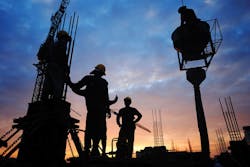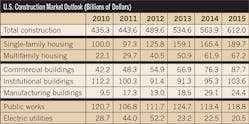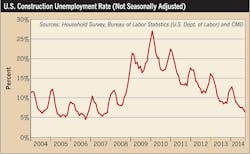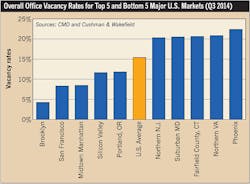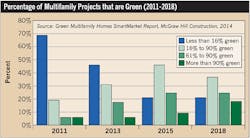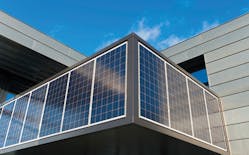The construction industry slipped into a long slump during the recession, but thanks to the strengthening of certain market segments, a more widespread recovery is starting to blossom.
“After the steep decline experienced a few years ago, the initial stage of recovery for the construction industry was often hesitant, encompassing just a few project types,” says Robert Murray, chief economist and vice president for Dodge Data & Analytics (formerly McGraw-Hill Construction). “One of the positive developments that’s emerged during 2014 is that the construction expansion is becoming more broad-based, and this trend should continue into 2015.”
Specifically, the institutional building segment of the nonresidential building market has turned the corner after five years of decline. This makes the expansion for the nonresidential building sector more diversified and also more resilient (see Fig. 1), says Murray.
Uncertainty, however, is still impacting certain sectors, like highway and bridge construction. If the successor bill to the recently expired two-year transportation bill, MAP-21, is passed during the first half of 2015, it could propel momentum in this sector. Currently, however, it remains to be seen whether or not this will happen, says Murray.
While the public works sector should edge up 5% next year, total construction starts should increase by 9% to $612 billion, following the 5% gain estimated for 2014, according to the annual forecast by Dodge Data & Analytics. In fact, five of the seven markets are expected to register a percentage increase next year. Only two markets — electric utilities and manufacturing buildings — are expected to drop in 2015 (Table 1).
“The measured pace of the current expansion resembles what took place during the first half of the 1990s, which also followed a financial crisis,” Murray says. “Given the slow unfolding of the current expansion, it has the potential to continue beyond 2015 and into 2016 and 2017.”
Like Dodge Data & Analytics, FMI is also seeing signs of a recovery. Its latest nonresidential construction index score was 62.8, which is 5.5 points higher than a year ago. The four key reasons for the optimism were that businesses are starting to build again, backlogs are expanding, inflation is low, and improved balance sheets are giving a sense of financial security.
The full recovery, however, may be years away for certain markets, says Dr. Kermit Baker, chief economist for the American Institute of Architects, in a recent Webcast titled, “Is the Pace of Construction Investment Set to Quicken?” He says nonresidential is still in the early days of the recovery, and it will be several more years until it returns to its pre-recession high. In addition, while housing is further along than other building activities, it has a long way to go, he says.
“In terms of where we are in the current construction cycle, we are moving in the right direction,” Baker says. “But I expected the market to bounce back a bit more, and I’m disappointed that we haven’t seen a stronger recovery.”
Economic impact
One of the key drivers of the construction industry is the global economy. After the world experienced one of the worst financial crises and recessions since the Great Depression, the United States is showing modest signs of recovery, says Paul Sheard, chief global economist and head of global economics and research for Standard & Poor’s.
“The global financial crisis cast a long shadow on the global economy, but the U.S. economy grew throughout this period,” he said during the November 2014 Outlook conference in Washington, D.C. “While it’s not stellar, it’s a recovery, and it has improved the economic outlook considerably.”
The United States is now in an expansion mode, which can help boost construction activity nationwide. For example, the construction industry confidence index grew over the last 12 months from 67 to 77, which is a very positive indication. Also promising is the decline in construction unemployment from 9% a year ago to 6.5% today, which shows a tightening market (Fig. 2), says Alex Carrick, the chief economist for CMD. The key challenge, however, is that when the economy took a sharp downturn, many workers left the industry.
“Employment in construction is nowhere close to being where it was before the recession or during the peak period,” said Carrick during a recent Webcast presented by CMD. “There is a shortfall of a million-and-a-half jobs, and we have to get more people into the industry.”
This may be easier said than done. Many of those who left the industry have either retired or gone back to school and are not waiting at home for contractors to call them back, according to Ken Simonson, chief economist for the Associated General Contractors of America. See Fig. 3 for a breakdown of changes in construction employment by state based on data collected between September 2013 and September 2014.
Reluctant residential recovery
When the economy took a sharp downturn, construction workers not only exited the industry, but homeowners were also forced out of their homes due to mortgage foreclosures. Six years later, the single-family housing market has taken longer to rebound than in other recovery period. One key reason is the legacy effect — just as Americans’ view of money changed after the Great Depression, homeowners who lost their homes are hesitant to purchase a house again after the Great Recession, Carrick says.
“It will take quite a while for that market to recover,” Carrick says. “The single-family housing market continues to be weak, and the starts are about half of what they were before the recession.”
While housing prices have increased by 30% after declining 34%, traditional site building, modular homes, and manufactured homes are still running well below levels, Baker says.
“When the housing prices hit the bottom, they bounced around for three years, and once the recovery began, they regained about two-thirds of what they lost,” Baker says. “I don’t expect them to get back to where they were before. They were overheated in many markets at unsustainably high levels.”
Back in 2005, free-wheeling mortgage practices artificially drove single-family housing starts up to 1.6 million, but by 2009, activity had fallen 73% to only 435,000, Murray says. By 2010, starts had improved by 3% to 446,000 units, only to be followed by a 7% decline in 2011 to 413,000 units. Since bottoming out in 2011, single-family housing starts through 2014 are up 53%, but the market is still at a historically weak level, Murray says. This sector will increase just 4% in dollar terms, corresponding to a meager 1% gain in the number of starts to 630,000. The recovery has stalled for two key reasons — investor demand for single-family housing has waned, and first-time home buyers continue to face tight bank lending standards, making it difficult for them to qualify for a mortgage, Murray says.
A stronger economy going into 2015, however, should help single-family housing regain some upward momentum, Murray says. Case in point: Dodge Data & Analytics is forecasting an 11% increase in single-family housing starts next year, due to job growth and greater mortgage availability.
Looking ahead, Baker says forecasters expect housing starts to hit a million this year and increase by 25% next year and 20% in 2016 (Table 2). Even if these aggressive and optimistic targets are met, Baker says the United States will still be below the traditional level of 1.7 to 1.8 million starts.
Over time, however, Simonson says he expects pent-up demand to drive growth in the single-family market. But in the meantime, millennial households are taking longer to form due to student debt levels, tight credit, high unemployment rates, and low wages.
“There is a further deceleration in single-family construction due to demographic and financial factors,” he says. “People are waiting longer to get married and have kids, which traditionally triggered some home building in the past.”
While the single-family market did not see much of a recovery in 2010-2011 and has struggled during 2014, the multifamily market has climbed steadily from 2010 through the present, Murray says. In fact, multifamily starts will reach 380,000 units this year, which is a 179% increase from its 2009 bottom. Next year, Dodge Data & Analytics expects the market to experience a 7% bump, which is a sign that the maturing multifamily expansion still has the capacity for further growth.
“What’s different for residential building in the current cyclical upturn is that so far it’s been led by multifamily instead of single-family housing,” Murray says. “Multifamily housing continues to be a favored target for the real estate investment community, and such positive market fundamentals as occupancy rates and rents are supporting further gains for construction.”
Commercial uptick
As the residential market has decelerated in 2014, the nonresidential building market has helped to pick up the slack. In particular, the commercial building portion of the nonresidential market segment is estimated to rise 8% (or 572 million sq ft) this year. This translates in dollars to a 14% gain, or $76.3 billion. For 2015, the commercial building segment is forecast to advance an additional 12% to 640 million sq ft. This translates to a 15% gain, or $87.7 billion, Murray says.
Within the commercial sector, the office construction market has recently begun to pick up the pace. This market bottomed out at 57 million sq ft in 2010 and then showed only modest improvement in recent years. This year, however, starts are estimated to be up 23% to 103 million sq ft, alongside a 28% increase to $27.2 billion. For 2015, office construction starts are forecast to climb 18% to 122 million square feet, with an accompanying 19% gain to $32.3 billion.
“While the early stage of the commercial building upturn was led by warehouses and hotels, office construction is now providing much of the upward momentum for this sector,” Murray says.
As the office market continues to recover, nontraditional sectors like data centers and corporate headquarters are playing a larger role, according to Dodge Data & Analytics. For example, Toyota is building a $350 million facility in Plano, Texas and construction is underway on Apple’s $2.3 billion facility in San Jose, Calif. Also, more companies are building data centers as they look to offload information to the Cloud. For example, Microsoft began building three data centers this year in Des Moines, Iowa, Washington State, and San Antonio, Texas.
Within the traditional office sector, however, vacancy rates are still at a high level. Even if the office vacancy rates are dropping, they are still high in many cities, and many companies are leaning toward shared office space, Carrick says. In fact, only five cities reported rates lower than 10%, including Boston; Manhattan, N.Y.; Charlotte, N.C.; San Francisco; and Portland, Ore. On average, the office vacancy rates were 15% as of the third quarter of this year, and the bottom five were all over 20% (Fig. 4).
Along with the office market, retail is also another key element of the commercial market. Lately, however, it has had a mixed picture, Murray says. For 2014, starts will decline by 2%, but next year, construction should grow moderately, helped by a stronger economy and housing market.
“Stores and shopping centers slipped back in 2014,” Murray says. “Next year, this project type is forecast to rise 11% — a gain similar to what is expected for single-family housing.”
As shown by the Dodge construction start statistics, more store projects are now located within large mixed-use projects than what was reported a decade ago. Additionally, the size of an average store project dropped substantially back in 2009, and has grown only slightly since then. The opposite, however, has happened within the warehouse sector. The average size of warehouse projects has swelled in recent years due, in part, to Amazon.com’s construction of new U.S. distribution facilities.
Overall, warehouse construction continues to strengthen. After posting a 9% gain in 2014, this market will grow in size by 12% to 179 million sq ft and in value by 14% to $11.7 billion in 2015. At the same time, another institutional market — hotel construction — also continues to move ahead at a healthy clip.
Starts for 2014 are estimated to climb 32% to 56 million sq ft, helped by rising occupancy levels and room rates. Occupancy rates during the first nine months of 2014 were close to 66%, and revenue per available room was up 8.2%. Further construction growth is predicted for 2015, as activity climbs 14% to 64 million sq ft. Carrick attributed the growth in this market to higher stock market values, which makes Americans feel wealthier.
“After years of belt tightening, we are starting to relax and enjoy ourselves a bit more, and it will show up in hotel construction,” he says.
Institutional incline
The institutional side of the nonresidential building market is now showing signs of growth. After five years of decline, this building market segment has finally stabilized and for 2014 is estimated to improve in size by 1% to 288 million sq ft and in value by 4% to $95.3 billion. The pace will pick up in 2015, as activity climbs 8% to 311 million sq ft and 9% to $103.6 billion, according to Dodge Data & Analytics.
Through the first nine months of 2014, primary schools, junior highs, high schools, colleges, and universities registered moderate construction gains from low levels, Murray says. The K-12 educational building market has recently shown some real promise. For example, the passage of major school construction bond measures is fueling growth in the education market, particularly in Texas.
“This increasing funding support is now beginning to have a positive impact at the construction site,” Murray says.
While the education market is trending upward, Murray indicates that construction of health care facilities is currently in a holding pattern, hovering at about 70 million sq ft per year. The market dipped in 2014, and is expected to rise slightly next year but still remain at a relatively low level of activity. One of the key reasons for the delayed investment in health care projects is continued uncertainty and the emphasis on cost containment that’s part of the Affordable Care Act.
“In line with this restrained activity, during the first nine months of 2014, there were 14 health care construction projects valued at $100 million or greater, whereas back in 2008, there were 39 such projects in the first nine months of the year that reached the groundbreaking stage,” Murray says. “It could be 2017 or 2018 before this market comes close to regaining the levels that were present toward the end of the previous decade.”
As the population continues to age, however, the country could face a heightened demand for health care facility construction down the road, Carrick says. In fact, by 2055, he estimated that there will be between 400,000 and 500,000 centenarians, which is enough to occupy an entire city the size of Reno, Nev.
To serve this population, Simonson expects to see more stand-alone emergency rooms, outpatient surgical centers, and clinics inside of grocery stores and pharmacies than traditional hospitals.
Energy boom
Going forward, electrical contractors and engineering firms may find new and emerging opportunities in the energy sector. For example, between 2017 and 2025, $27 billion of crude oil pipelines will be built, and the natural gas distribution industry plans to spend $275 billion in reinforcement and improvement projects to create fewer leaks, a longer life, and improved safety.
“The energy industry is changing with supply and demand,” says Branko Terzic, president and chief executive officer for Branko Terzic & Associates. “It is a time when we need more energy production facilities and more pipelines. We need to expand the entire energy infrastructure to handle the oil and gas demands.”
Much of the investment is tied to the regulatory approval of the Keystone pipeline. If the project is given the green light, it would add another 1,200 miles to the 150,000 miles of pipeline already in the United States and would help North America to become more energy self-sufficient, Carrick says.
As regulators contemplate the routing and environmental implications of the new pipeline, another trend shaping construction is that of the shale gale, Simonson says. Each well will require an access road, site preparation, a pad, a storage pond, support structures, and pipes. Also, demand will increase for steel, power, and petrochemical plants as well as liquefied natural gas export terminals.
“The huge drop in oil prices will cause a cutback in drilling, but the natural gas liquids that remain are quite valuable,” Simonson says. “The new abundance of natural gas and oil will help utilities and manufacturers and will affect the number of plants that drill, pump, process, and store it.”
As more infrastructure is being built to handle and process the natural gas, existing coal-fired and carbon-fueled power plants are facing increased resistance and more regulations on emissions, Terzic says. As a result, utilities will have to retrofit their coal-fired plants with pollution controls or build new natural gas-fired plants.
In terms of nuclear power, Terzic says the outlook is rather bleak in North America. For example, in 2013, 6 GW of nuclear power was retired, and only two plants have been approved by regulators for construction in the United States. In comparison, the development of 20 nuclear power plants is now underway in India, Russia, and South Korea.
This year, the electric power and gas plant category is expected to drop 3% to $22.5 billion, compared to the 56% plunge in 2013. During the first nine months of 2014, large power plant retrofits and new projects were underway in states such as Illinois, Texas, Florida, and Nevada.
“There will be some further softening of the electric utility market, but the decline will not be as severe as what took place in 2013,” Murray says.
The electric utility market experienced a large surge in construction starts during 2011 and 2012. As a result, more power plants are now coming online, and capacity utilization rates for electric power generation are slipping. The number of new alternative energy power plants remains strong but is dropping back from levels achieved a couple of years ago, while the groundbreaking for natural gas-fired power plants has strengthened in 2014, says Murray.
“The expected start of several massive LNG projects will provide support to the overall electric utility category going forward,” he says.
Transmission line projects were particularly strong in 2010 and 2011, and are currently in a bit of a pause but expected to rebound in 2015. In fact, according to NERC’s Long Term Reliability Assessment, the electric utility industry plans to build 18,300 miles of new transmission and distribution capacity, and another 6,800 miles of capacity additions is under review.
The United States experienced a significant increase in manufacturing plant construction in terms of dollar value, and several of the projects were energy-related. Specifically, many energy-related projects were constructed in the Gulf Coast region of Texas, and petrochemical work was up more than 100% in 2014.
“Given the stronger economy, more clients are inclined to go ahead with projects,” Simonson says. “When looking at the general picture for manufacturing, there is more growth ahead, but I’m not sure if the energy and petrochemical plants can sustain the same pace in 2015.”
Energy efficiency
Both the energy market and the green building industry are showing future promise in many markets (see Fig. 5). For example, federal buildings are currently undergoing retrofit projects to heighten their energy efficiency.
The residential renewable energy market is also expected to grow rapidly over the next three years, especially the multifamily sector (Fig. 6), says Harvey Bernstein, vice president of Industry Insights and Alliances for Dodge Data & Analytics.
“Green building is not a fad, but is clearly a permanent part of the industry,” Bernstein says. “The office, retail, hotel, and school markets are showing growth in green when it comes to construction.”
Another trend in terms of green building relates to the health and wellness of the building occupants through low VOC products, nontoxic building materials, and acoustic comfort, he says.
With this year set to be the hottest on record, the building industry is striving to reduce energy consumption and improve performance, says Robert Perciasepe, president of the Center for Climate and Energy Solutions. Case in point: 50 buildings in Denver have a volunteer energy efficiency program, which can save $1.3 billion in energy costs. Additionally, the United States has $3 billion sq ft of LEED-certified buildings, and the market for green buildings is about 50% of the market for new commercial construction, he says. Rather than wait for the federal government to develop broader energy framework, some states already are adopting clean air or energy efficiency programs.
“Solar, wind, nuclear, and hydro now account for one-third of the electricity generated in the United States,” Perciasepe says. “The energy train has already left the station, and many states already have programs.”
Looking forward, electrical construction and engineering firms can benefit from the uptick in green projects and the slow yet steady recovery across diverse markets. Inch by inch, however, the markets are posting gains, and the opportunities are beginning to unfold as more work is coming into firms, Baker says.
“Many of the firms are reporting that the projects that were put on hold are finally beginning to resurface,” Baker says. “There is a healthy growth in construction as we move into the second half of next year.”
Fischbach is a freelance writer based in Overland Park, Kansas. She can be reached at [email protected].
SIDEBAR: Construction Trends for 2015
Harvey Bernstein, vice president of Industry Insights and Alliances for Dodge Data & Analytics, shared three trends that could affect the construction industry in 2015.
Move to BIM. When looking ahead, electrical design and contracting firms can expect to see more BIM projects due to the modeling method’s ability to reduce errors and emissions, collaborate, reduce rework, and have better cost control.
“Communication is very important across the board,” Bernstein says. “BIM can help to mitigate owner-driven changes and unforeseen conditions and reduce the uncertainty.”
Focus on lean construction. An increasing number of owners are focusing on lean construction because it can help to provide greater consistency and a reduced project schedule.
Increase in design-build projects. In addition, design-build is expected to surpass design-bid-build as the predominant delivery method going forward, Bernstein says.
“From the contractors’ perspective, they are experiencing a real shift in the use of design-build due to lower costs, shorter schedules, and more owner satisfaction,” he says.

